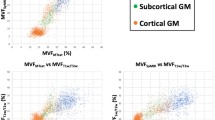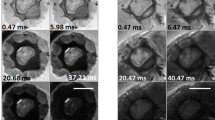Abstract
Objective
Magnetization EXchange (MEX) sequence measures a signal linearly dependent on the myelin proton fraction by selective suppression of water magnetization and a recovery period. Varying the recovery period enables extraction of the percentile fraction of myelin bound protons. We aim to demonstrate the MEX sequence sensitivity to the fraction of protons associated with myelin in mice brain, in vivo.
Methods
The cuprizone mouse model was used to manipulate the myelin content. Mice fed cuprizone (n = 15) and normal chow (n = 8) were imaged in vivo using MEX sequence. MR images were segmented into corpus callosum and internal capsule (white matter) and cortical gray matter, and fitted to the recovery equation. Results were analyzed with correlation to MWF and histopathology.
Results
The extracted parameters show significant differences in the corpus callosum between the cuprizone and control groups. The cuprizone group exhibited reduced myelin fraction 26.5% (P < 0.01). The gray matter values were less affected, with 13.5% reduction (P < 0.05); no changes were detected in the internal capsule. Results were validated by MWF scans and good correlation to the histology analysis (R2 = 0.685).
Conclusion
The results of this first in vivo implementation of the MEX sequence provide a quantitative measure of demyelination in brain white matter.







Similar content being viewed by others
Abbreviations
- MT:
-
Magnetization transfer
- UTE:
-
Ultra-short TE
- MWF:
-
Myelin water fraction
- MEX:
-
Magnetization exchange
- GM:
-
Gray matter
- WM:
-
White matter
- SIR:
-
Selective inversion recovery
- MS:
-
Multiple sclerosis
- EAE:
-
Experimental autoimmune encephalitis
- ROI:
-
Region of interest
- CC:
-
Corpus callosum
- sCC:
-
Splenium corpus callosum
- cGM:
-
Cortical gray matter
- IC:
-
Internal capsule
- FLASH:
-
Fast low angle shot
- MSME:
-
Multi-slice-multi-echo
- RARE:
-
Rapid acquisition with relaxation enhancement
- MBP:
-
Myelin basic protein
References
Mehta RC, Pike GB, Enzmann DR (1996) Magnetization transfer magnetic resonance imaging: a clinical review. Top Magn Reson Imaging 8(4):214–230
van Zijl PCM, Lam WW, Xu J, Knutsson L, Stanisz GJ (2018) Magnetization transfer contrast and chemical exchange saturation transfer MRI. Features and analysis of the field-dependent saturation spectrum. Neuroimage 168:222–241. https://doi.org/10.1016/j.neuroimage.2017.04.045
McKeithan LJ, Lyttle BD, Box BA et al (2019) 7T quantitative magnetization transfer (qMT) of cortical gray matter in multiple sclerosis correlates with cognitive impairment. Neuroimage 203:116190. https://doi.org/10.1016/j.neuroimage.2019.116190
Dortch RD, Li K, Gochberg DF et al (2011) Quantitative magnetization transfer imaging in human brain at 3 T via selective inversion recovery. Magn Reson Med 66(5):1346–1352. https://doi.org/10.1002/mrm.22928
Gochberg DF, Kennan RP, Gore JC (1997) Quantitative studies of magnetization transfer by selective excitation and T1 recovery. Magn Reson Med 38(2):224–231. https://doi.org/10.1002/mrm.1910380210
Dortch RD, Bagnato F, Gochberg DF, Gore JC, Smith SA (2018) Optimization of selective inversion recovery magnetization transfer imaging for macromolecular content mapping in the human brain. Magn Reson Med 80(5):1824–1835. https://doi.org/10.1002/mrm.27174
Wilhelm MJ, Ong HH, Wehrli SL et al (2012) Direct magnetic resonance detection of myelin and prospects for quantitative imaging of myelin density. Proc Natl Acad Sci USA 109(24):9605–9610. https://doi.org/10.1073/pnas.1115107109
Du J, Ma G, Li S et al (2014) Ultrashort echo time (UTE) magnetic resonance imaging of the short T2 components in white matter of the brain using a clinical 3T scanner. Neuroimage 87:32–41. https://doi.org/10.1016/j.neuroimage.2013.10.053
Campbell JSW, Leppert IR, Narayanan S et al (2018) Promise and pitfalls of g-ratio estimation with MRI. Neuroimage 182:80–96. https://doi.org/10.1016/j.neuroimage.2017.08.038
Stikov N, Campbell JSW, Stroh T et al (2015) In vivo histology of the myelin g-ratio with magnetic resonance imaging. Neuroimage 118:397–405. https://doi.org/10.1016/j.neuroimage.2015.05.023
Laule C, Vavasour IM, Kolind SH et al (2007) Magnetic resonance imaging of myelin. Neurotherapeutics 4(3):460–484. https://doi.org/10.1016/j.nurt.2007.05.004
Laule C, Moore GRW (2018) Myelin water imaging to detect demyelination and remyelination and its validation in pathology. Brain Pathol 28(5):750–764. https://doi.org/10.1111/bpa.12645
Alonso-Ortiz E, Levesque IR, Pike GB (2015) MRI-based myelin water imaging: a technical review. Magn Reson Med 73(1):70–81. https://doi.org/10.1002/mrm.25198
Leandrou S, Petroudi S, Kyriacou PA, Reyes-Aldasoro CC, Pattichis CS (2018) Quantitative MRI Brain studies in mild cognitive impairment and Alzheimer’s disease: a methodological review. IEEE Rev Biomed Eng 11:97–111. https://doi.org/10.1109/RBME.2018.2796598
Ben-Eliezer N, Sodickson DK, Block KT (2015) Rapid and accurate T2 mapping from multi-spin-echo data using Bloch-simulation-based reconstruction. Magn Reson Med 73(2):809–817. https://doi.org/10.1002/mrm.25156
Eliav U, Navon G (2017) The role of magnetization transfer in the observed contrast in T1weighted imaging under clinical setups. NMR Biomed 30(12):e3792. https://doi.org/10.1002/nbm.3792
Edzes HT, Samulski ET (1978) The measurement of cross-relaxation effects in the proton NMR spin-lattice relaxation of water in biological systems: hydrated collagen and muscle. J Magn Reson 31(2):207–229. https://doi.org/10.1016/0022-2364(78)90185-3
Morrison C, Mark HR (1995) A model for magnetization transfer in tissues. Magn Reson Med 33(4):475–482. https://doi.org/10.1002/mrm.1910330404
Callaghan PT (1991) Principles of nuclear magnetic resonance microscopy. Med Phys. https://doi.org/10.1118/1.596918
Bydder GM, Hajnal JV, Young IR (1998) MRI: Use of the inversion recovery pulse sequence. Clin Radiol 53(3):159–176. https://doi.org/10.1016/S0009-9260(98)80096-2
Gochberg DF, Gore JC (2007) Quantitative magnetization transfer imaging via selective inversion recovery with short repetition times. Magn Reson Med 57(2):437–441. https://doi.org/10.1002/mrm.21143
Torkildsen A, Brunborg LA, Myhr KM, Bø L (2008) The cuprizone model for demyelination. Acta Neurol Scand 117(SUPPL 188):72–76. https://doi.org/10.1111/j.1600-0404.2008.01036.x
Matsushima GK, Morell P (2006) The neurotoxicant, cuprizone, as a model to study demyelination and remyelination in the central nervous system. Brain Pathol 11(1):107–116. https://doi.org/10.1111/j.1750-3639.2001.tb00385.x
Teklad Custom Diets (2016) Research models and services teklad custom diets cuprizone diets: a trusted tool for neuroscience research https://www.mendeley.com/catalogue/f2ef99c6-
Ding S, Guo Y, Chen X et al (2021) Demyelination and remyelination detected in an alternative cuprizone mouse model of multiple sclerosis with 7.0 T multiparameter magnetic resonance imaging. Sci Rep 11(1):1–11. https://doi.org/10.1038/s41598-021-90597-6
Mullin AP, Cui C, Wang Y et al (2017) rHIgM22 enhances remyelination in the brain of the cuprizone mouse model of demyelination. Neurobiol Dis 105:142–155. https://doi.org/10.1016/J.NBD.2017.05.015
Steelman AJ, Thompson JP, Li J (2012) Demyelination and remyelination in anatomically distinct regions of the corpus callosum following cuprizone intoxication. Neurosci Res 72(1):32–42. https://doi.org/10.1016/J.NEURES.2011.10.002
Wang Z, Baharani A, Wei Z et al (2021) Low field magnetic stimulation promotes myelin repair and cognitive recovery in chronic cuprizone mouse model. Clin Exp Pharmacol Physiol 48(8):1090–1102. https://doi.org/10.1111/1440-1681.13490
Saskia Hübner N, Mechling AE, Lee HL et al (2017) The connectomics of brain demyelination: Functional and structural patterns in the cuprizone mouse model. Neuroimage 146:1–18. https://doi.org/10.1016/J.NEUROIMAGE.2016.11.008
Eliav U, Ronen I, Halock K, Kim DSNGM (2007) Magnetization exchange (MEX) MRI: a clinically viable protein-based imaging method. ISMRM-ESMRMB meeting. Springer, Berlin
Stanisz GJ, Kecojevic A, Bronskill MJ, Henkelman RM (1999) Characterizing white matter with magnetization transfer and T2. Magn Reson Med 42(6):1128–1136. https://doi.org/10.1002/(SICI)1522-2594(199912)42:6%3c1128::AID-MRM18%3e3.0.CO;2-9
Leibfritz D, Dreher W (2001) Magnetization transfer MRS. NMR Biomed 14(2):65–76. https://doi.org/10.1002/nbm.681
Smith SA, Edden RAE, Farrell JAD, Barker PB, Van Zijl PCM (2008) Measurement of T 1 and T 2 in the cervical spinal cord at 3 tesla. Magn Reson Med 60(1):213–219. https://doi.org/10.1002/mrm.21596
van Gelderen P, Jiang X, Duyn JH (2016) Effects of magnetization transfer on T1 contrast in human brain white matter. Neuroimage 128:85–95. https://doi.org/10.1016/j.neuroimage.2015.12.032
Fatouros PP, Marmarou A (1999) Use of magnetic resonance imaging for in vivo measurements of water content in human brain: method and normal values. J Neurosurg 90(1):109–115. https://doi.org/10.3171/jns.1999.90.1.0109
Edzes H, Nature ES (1977) Cross relaxation and spin diffusion in the proton NMR of hydrated collagen. Springer, Berlin. https://doi.org/10.1038/265521a0
Eliav U, Navon G (2002) Multiple quantum filtered NMR studies of the interaction between collagen and water in the tendon. J Am Chem Soc 124(12):3125–3132
Dula AN, Gochberg DF, Valentine HL, Valentine WM, Does MD (2010) Multiexponential T2, magnetization transfer, and quantitative histology in white matter tracts of rat spinal cord. Magn Reson Med 63(4):902–909. https://doi.org/10.1002/mrm.22267
Hiremath MM, Saito Y, Knapp GW, Ting JP-Y, Suzuki K, Matsushima GK (1998) Microglial/macrophage accumulation during cuprizone-induced demyelination in C57BL/6 mice. J Neuroimmunol 92(1–2):38–49. https://doi.org/10.1016/S0165-5728(98)00168-4
Dorr AE, Lerch JP, Spring S, Kabani N, Henkelman RM (2008) High resolution three-dimensional brain atlas using an average magnetic resonance image of 40 adult C57Bl/6J mice. Neuroimage 42(1):60–69. https://doi.org/10.1016/j.neuroimage.2008.03.037
Bjarnason TA, Mitchell JR (2010) AnalyzeNNLS: magnetic resonance multiexponential decay image analysis. J Magn Reson 206(2):200–204. https://doi.org/10.1016/j.jmr.2010.07.008
Hibbits N, Yoshino J, Le TQ, Armstrong RC (2012) Astrogliosis during acute and chronic cuprizone demyelination and implications for remyelination. ASN Neuro 4(6):AN20120062. https://doi.org/10.1042/AN20120062
Turati L, Moscatelli M, Mastropietro A et al (2015) In vivo quantitative magnetization transfer imaging correlates with histology during de- and remyelination in cuprizone-treated mice. NMR Biomed 28(3):327–337. https://doi.org/10.1002/nbm.3253
Acknowledgements
This work is dedicated to the memory of our beloved colleague and NMR mentor, Dr. Uzi Eliav. Dr. Eliav’s role over the years in developing multiple NMR methods, including the MEX method, and his role in this particular work were pivotal. His friendship and wisdom will be missed.
Funding
This study was facilitated by funding from the Israeli Science Foundation (ISF grant no. 1585/17) granted to U.N. and from the U.S.‐Israel Binational Science Foundation (BSF grant no. 2013253) to G.N. and U.E.
Author information
Authors and Affiliations
Corresponding author
Ethics declarations
Conflict of interest
All the authors declare that they have no conflict of interest.
Ethical approval
All applicable international, national, and/or institutional guidelines for the care and use of animals were followed. (approval # M-01-17-095).
Ethical statement
The research was carried out in accordance with the ethics declaration at the animal care unit of the Faculty of Medicine, Tel Aviv University (approval # M-01-17-095).
Additional information
Publisher's Note
Springer Nature remains neutral with regard to jurisdictional claims in published maps and institutional affiliations.
Uzi Eliav: Died December 19th, 2019.
Supplementary Information
Below is the link to the electronic supplementary material.
Rights and permissions
About this article
Cite this article
Wilczynski, E., Sasson, E., Eliav, U. et al. An in vivo implementation of the MEX MRI for myelin fraction of mice brain. Magn Reson Mater Phy 35, 267–276 (2022). https://doi.org/10.1007/s10334-021-00950-z
Received:
Revised:
Accepted:
Published:
Issue Date:
DOI: https://doi.org/10.1007/s10334-021-00950-z




